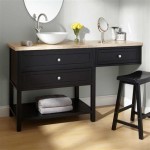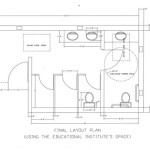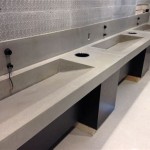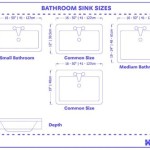What Are Bathroom Vanity Sinks Made Of In The Netherlands?
Bathroom vanity sinks in the Netherlands, much like in other parts of Europe, are manufactured from a variety of materials, each offering distinct aesthetic and practical benefits. Understanding the characteristics of these materials can help consumers make informed decisions when renovating or designing their bathrooms.
Ceramic
Ceramic sinks remain a popular choice due to their affordability, durability, and classic appearance. They are made from clay fired at high temperatures, creating a hard, waterproof surface. Ceramic sinks are also relatively easy to clean and maintain.
- Cost-effective option.
- Resistant to scratches and stains.
- Widely available in various shapes and sizes.
- Simple to clean and maintain.
- Can chip or crack under heavy impact.
Porcelain
Porcelain is a type of ceramic but is made with finer clay and fired at even higher temperatures. This process results in a denser, more durable, and less porous material than standard ceramic. Porcelain sinks offer a higher-end look and feel, and often come in more refined shapes and designs.
- More durable and resistant to chipping than ceramic.
- Smoother, more luxurious surface.
- Higher price point than ceramic.
- Available in a range of stylish designs.
Vitreous China
Vitreous china is a specific type of porcelain with an even finer, denser composition. The manufacturing process involves adding a glass-like coating, which further enhances its durability and resistance to stains and scratches. Vitreous china is a premium material often used in high-end bathroom fixtures.
- Extremely durable and long-lasting.
- Highly resistant to stains, scratches, and chipping.
- Non-porous surface prevents bacterial growth.
- More expensive than standard porcelain or ceramic.
Stone
Natural stone sinks provide a unique and luxurious aesthetic, adding a touch of elegance to any bathroom. Popular stone options include granite, marble, and travertine. Each stone type offers distinct veining and coloring, creating a truly individual look.
- Natural beauty and unique appearance.
- Durable and long-lasting with proper care.
- Can be susceptible to staining and scratching depending on the stone type.
- Requires sealing to prevent water damage and staining.
- Higher cost compared to ceramic options.
Solid Surface
Solid surface sinks are made from a composite material typically consisting of acrylic or polyester resins mixed with mineral fillers. This material allows for seamless integration with countertops and offers a wide range of design possibilities. Solid surface sinks are also non-porous and easy to clean.
- Seamless, integrated look with countertops.
- Non-porous and hygienic surface.
- Available in a variety of colors and styles.
- Can be repaired if scratched or damaged.
- Moderately priced.
Glass
Glass sinks offer a contemporary and stylish look, adding a touch of elegance and visual lightness to a bathroom. They are typically made from tempered glass, which is more resistant to breakage than standard glass. Glass sinks are available in a variety of colors and textures, from clear and frosted to patterned and textured.
- Modern and stylish design element.
- Creates a sense of spaciousness.
- Can show water spots and fingerprints easily.
- Can be more fragile than other materials.
Metal
Metal sinks, typically made from stainless steel, copper, or brass, are gaining popularity in modern bathroom designs. They offer a sleek and industrial aesthetic and are highly durable. Metal sinks are also resistant to scratches, stains, and heat.
- Durable and resistant to scratches, stains, and heat.
- Modern and industrial aesthetic.
- Can be noisy when water hits the surface.
- May require specific cleaning products to avoid damage.
Composite
Composite sinks are crafted from a blend of materials, often combining crushed granite or quartz with resin. This combination provides the look and feel of natural stone with added durability and stain resistance. Composite sinks offer a versatile option that combines aesthetics with practicality.
- Durable and resistant to stains and scratches.
- Mimics the appearance of natural stone.
- Wide range of colors and styles.
- Less expensive than natural stone.
Ultimately, the best material for a bathroom vanity sink depends on individual preferences, budget, and the overall design of the bathroom. Considering the characteristics of each material will help homeowners in the Netherlands select the perfect sink for their needs.

Custom Made Natural Limestone Bathroom Sink

Alba Modern Single Integrated Glass Top Vanity

Danya 32 Inch Modern Bathroom Vanity Black Silver

Double Sink Bathroom Vanity Units Plwy18168

Ceramic Bathroom Vanity Sink Leaf And Flower Decorative Vessel Countertop Single Bowl For Lavatory Glossy Washbasin Cloakroom

Danya Silver And Black Modern Bathroom Vanity

Ceramic Unique Wash Basin Bathroom Vessel Sink Above Countertop Bowl Lavatory Remodel Bath Vanity Glossy Washstand

Danya 40 Inch Modern Bathroom Vanity Black Gold

Ten S Designed For Contemporary Bathroom Interiors

Bathroom Sink Hand Painted Countertop Basin Vanity Recessed Glossy Wash Vessel Above Counter Room Remodel
Related Posts







